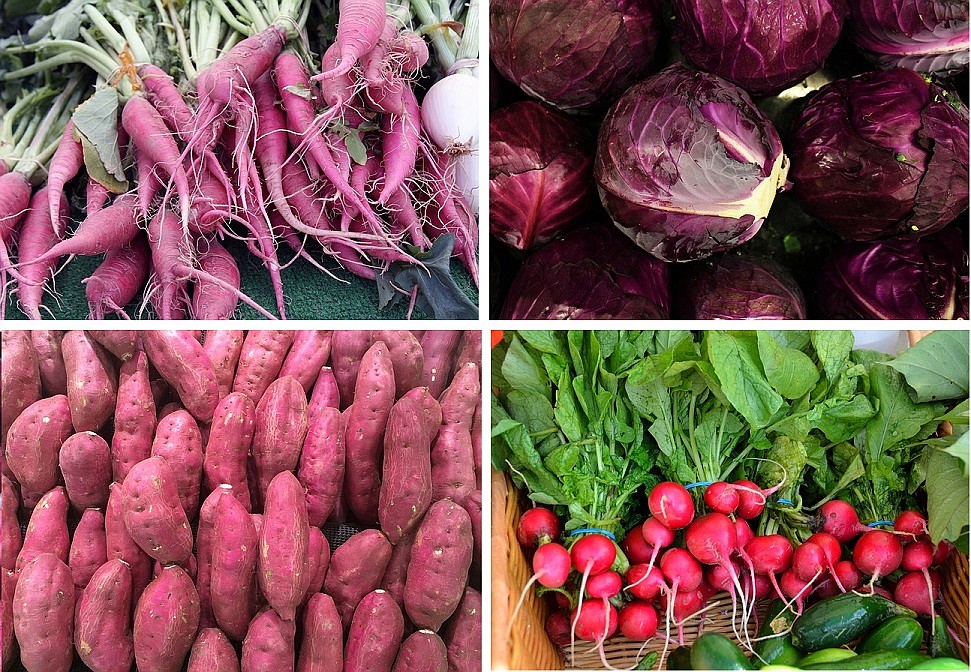Red and Purple Vegetables Move Front and Center
March 8, 2023 at 7:59 a.m.
The red, purple and blue pigments in fruits, vegetables and tubers are called anthocyanins, which can reduce the risk of diabetes
...by JOHN SCHIESZER
A new review article comparing research results has demonstrated that the beneficial effect of anthocyanins on type 2 diabetes is increased if the anthocyanin is acylated. This means that an acylated group is added to the anthocyanin.
A great amount of acylated anthocyanins can be found in purple potatoes, purple sweet potatoes, radishes, purple carrots and red cabbages, whereas salmonberries, bilberries and mulberries contain mostly non-acylated anthocyanins. Acylated anthocyanins are poorly absorbed in digestion, but they have probiotic properties and reduce the risk of diabetes more efficiently than non-acylated anthocyanins.
"The studies have shown that, in addition to changing physical and chemical properties, the acylation affects how the anthocyanins are absorbed and metabolized," said study investigator Kang Chen, who is with the Food Sciences Unit at the University of Turku in Finland.
The acylated anthocyanins are more effective antioxidants than the non-acylated anthocyanins, and they can also improve the intestinal barrier that enables the absorption of necessary nutrients. Furthermore, the acylated anthocyanins are good for the gut. They suppress pro-inflammatory pathways and modulate glucose and lipid metabolisms. "The plant's genotype defines what kind of anthocyanins they produce. In general, purple vegetables contain many acylated anthocyanins," says Chen.
Acylated anthocyanins travel through the upper gastrointestinal tract to the colon where they are metabolized by the gut microbiota. Glucose transporters are involved in anthocyanin absorption, but different glucose transporters are responsible for the absorption of acylated and non-acylated anthocyanins.
Improving Your Gut Health
It’s probably no surprise that the gut microbiome plays a role in digestion, metabolism, and inflammation, but the intestinal tract is also home to about 70-80% of our immune-producing cells. There’s evidence that gut health plays a role in prevention of cardiovascular disease, cancer, hormone disorders, and a host of other chronic conditions.
The easiest and most effective way to support your gut health is by eating a balanced diet with fiber rich in fruits, vegetables, legumes and whole grains. Equally important is limiting alcohol consumption and other medications that may negatively impact the gut microbiome.
Fiber-rich foods, like beans, lentils, oats, whole wheat, nuts, seeds, and vegetables are important to maintaining a healthy gut. Fiber comes in two varieties: soluble and insoluble. Insoluble fiber is not easily digested but helps promote regular bowel movements and prevent constipation. Soluble fiber on the other hand absorbs water, forming a gel that is consumed by gut bacteria.
Registered Dietitian Sharon Palmer, is the author of The Plant-Powered Plan to Beat Diabetes, said for adults over 50, one of the biggest nutrition issues is eating to prevent chronic disease risk during aging, which includes heart disease, type 2 diabetes, hypertension, cancer, and obesity. "Research shows you can significantly reduce your risk of these chronic diseases through diet," said Palmer. "Eating a more plant-based diet filled with whole grains, soy foods, pulses (beans, lentils, peas), vegetables, fruits, nuts, and seeds can reduce your risks of all of these conditions, which can help you live a longer, more high-quality life."
She said most Americans fall short on eating these whole plant foods, in particular vegetables, but also pulses, whole grains and fruits. "We are eating too many highly processed foods and red/processed meat. By eating more whole plant foods, you basically push the less healthful options off your plate," said Palmer.
What About Plant-Based Milks?
“It’s important for consumers to educate themselves about what food labels tell us about what we are putting into our bodies. The largest nutritional differences are with protein and carbohydrates,” said Wright. “While plant-based beverages might contain as much protein as dairy milk, the key piece of information that consumers don’t always know is that not all protein is equal when it comes to human digestion.”
The major components making up carbohydrates in plant-based milks are fiber, and -- if you don't choose an unsweetened option -- added sugar. Wright said dairy milks have no fiber, so all of the carbohydrates come from sugars. If you don't choose unsweetened plant-based milk, almost 100% of the sugar in plant-based beverages are added sugars.
“The recent FDA decision to add to the nutrition facts panel makes a distinction between natural sugars (like the lactose in milk) and added sugars.
Wright explains that most of the plant-based milk options (oat, almond, rice, coconut, hemp, cashew, hazelnut, soy, pea, flaxseed, and sesame) have similar nutrition profiles.
As the director of the Food Producer Technical Assistant Network at Virginia Tech, Wright supports food entrepreneurs by assisting with starting a food business, nutrition label content, food safety analysis, and pertinent food regulations. "Gut health is the balance of good microorganisms to bad microorganisms in your digestive tract. This balance can be affected by diet, medications, genetics and, science suggests, even by age," said Wright.
She said adults 50 and older should make a choice based on facts as well as their personal preference. The facts are that switching to plant-based milk from dairy milk may introduce more fiber into someone’s diet, but it can also introduce more added sugars unless you choose the unsweetened options.
John Schieszer is an award-winning national journalist and radio and podcast broadcaster of The Medical Minute. He can be reached at medicalminutes@gmail.com.





